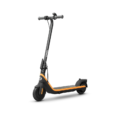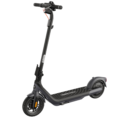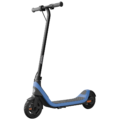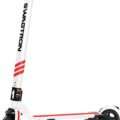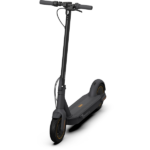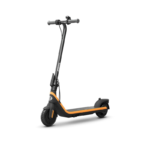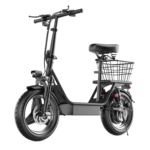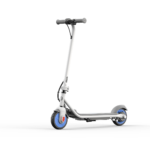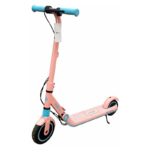- Home
- Scooters
- Electric Scooters
- Segway Ninebot ZING C8
Segway Ninebot ZING C8
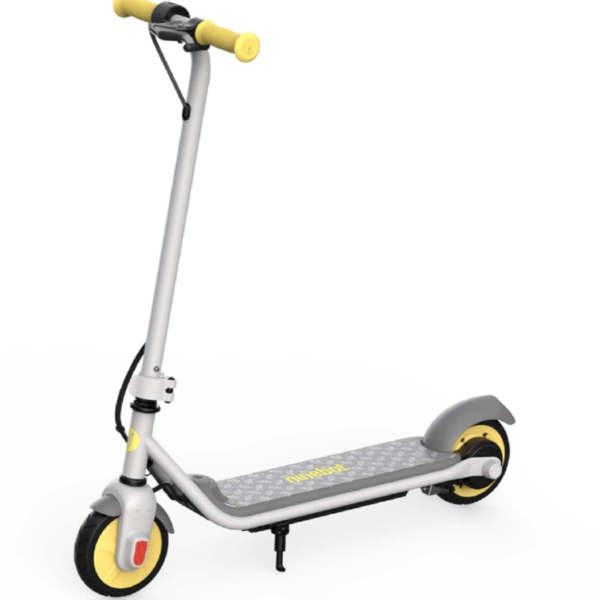

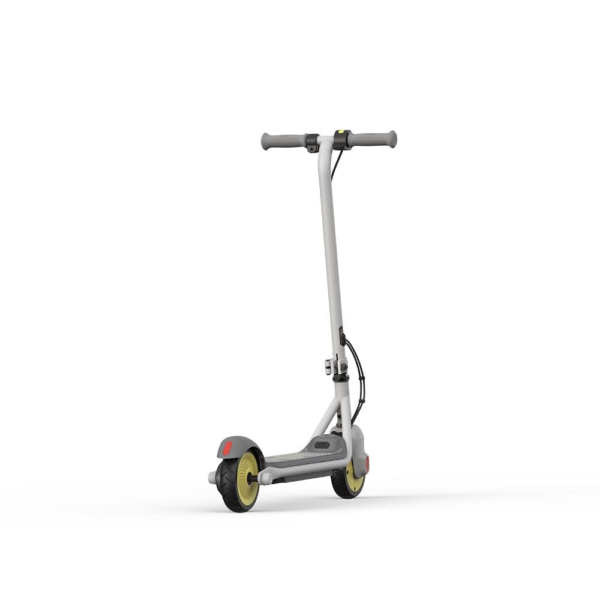
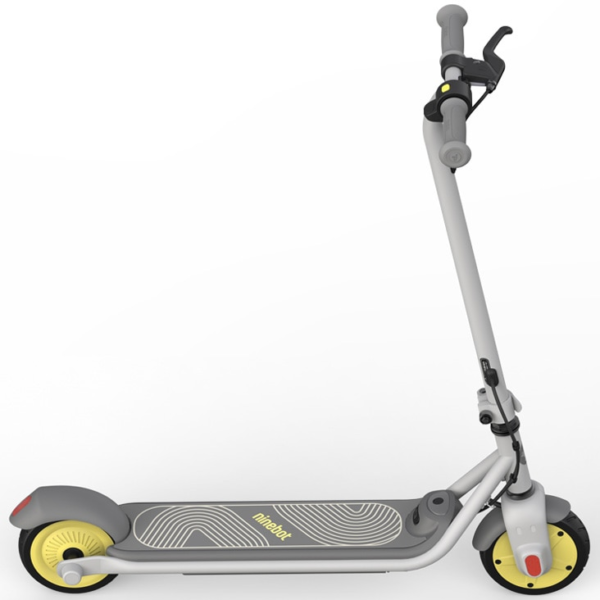
- Battery Range: 10 km (6.2 mi)
- Top Speed: 16 km/h (10 mph)
- Motor Power: 120 W nominal
- Weight Capacity: 50 kg (110 lb)
- Charging Time: 2.5 h
- Scooter Weight: 9.0 kg (19.8 lb)
PROS
- Kid-friendly 16 km/h cap
- Quick 2.5 h charging
- Solid tyres: no flats
- Hand-operated rear brake
- IPX4 body, Smart BMS
- Three riding modes
CONS
- Short range for long park days
- No suspension
- No fold (stem quick-release only)
- No app connectivity
- Rear brake only; no brake light


Overview: Safe, Simple Fun for Ages 6–12
The Segway Ninebot C8 is a kids’ eKickScooter designed to make first rides feel safe, simple, and genuinely fun. It focuses on the essentials that matter most to families: easy control, predictable stopping, and low maintenance. With a kid-sensible top speed up to 16 km/h, up to 10 km of range, and solid rubber tyres that never need tubes, the C8 gives young riders a forgiving, confidence-building platform. Moreover, a hand-operated rear brake provides smooth, progressive lever feel, while three riding modes—Safe, Cruise, and Turbo—let children progress step by step. Because the compact frame is sized for riders roughly 115–145 cm tall, the scooter fits growing kids without feeling awkward or oversized.
Parents will appreciate the quick charging time—about 2.5 hours from low—since it makes after-school top-ups practical. In addition, the C8 carries an IPX4 splash-resistance rating and a smart BMS that protects the 54 Wh battery against common issues. Consequently, the C8 is ready for short neighborhood rides, school-yard practice, and weekend park loops—without turning family time into maintenance time.
Who the Segway Ninebot C8 Is For
The C8 suits families who want a sensible first electric scooter that kids can learn on, enjoy, and maintain easily. Specifically, it’s ideal for:
- First-time riders in the 6–12 age range who need gentle speed and stable handling.
- Parents who prefer predictable braking, puncture-proof tyres, and simple routines.
- Neighborhood routes such as quiet streets, cul-de-sacs, shared paths, and school courts.
- Households with limited storage, since the compact footprint stows neatly by a door or in a hallway.
Because the C8 emphasizes control over drama, it helps kids build the right habits early—smooth starts, calm turns, and thoughtful braking—so every ride feels safer and more enjoyable. As a result, families tend to ride more often and with less stress.
Design Philosophy: Confidence First
Everything about the C8’s design aims at confidence. To begin with, the deck height is friendly and low, so stepping on and off feels natural rather than wobbly. Likewise, the handlebars sit at a comfortable reach for smaller riders, which reduces over-correction and keeps steering precise. The cockpit also stays clean: a simple display, an easy thumb throttle, and a single brake lever. Thus, kids see what matters at a glance.
Style also matters at kid speeds. Accordingly, the C8’s clean lines and bright accents look modern without shouting. Because the scooter appears approachable, new riders relax sooner and focus on the path ahead.
Motor & Throttle: Smooth, Predictable Power
On a children’s scooter, how power arrives matters more than how much power there is. Therefore, the C8’s brushless motor is tuned for smooth launches and steady cruising. Instead of jerking forward, the scooter eases into motion as the rider rolls on the thumb throttle. This predictable ramp-up encourages a relaxed stance—elbows soft, head up, eyes forward.
At up to 16 km/h, the top speed strikes a thoughtful balance: exciting enough to feel like a “real scooter,” yet measured enough to support learning. Furthermore, because the throttle has a progressive throw, kids quickly understand how small inputs affect speed—an essential lesson for safe riding everywhere.
Three Riding Modes: Safe → Cruise → Turbo
Progress sticks when it’s structured. For that reason, the C8’s modes give parents and riders a clear ladder:
- Safe Mode: Reduced top speed and gentle acceleration help new riders master mounting, coasting, and controlled stopping.
- Cruise Mode: Balanced response and comfortable cruising speed suit everyday loops on smooth, open paths.
- Turbo Mode: The most responsive mapping within the 16 km/h cap adds a bit of zing for confident riders—still sensible, never overwhelming.
Because mode changes are quick, adults can set daily limits and unlock more as skills improve. Consequently, this stepwise approach keeps learning calm, visible, and motivating.
Braking You Can Trust: Hand-Operated Rear Brake
Stopping power should feel predictable, especially for small hands. Accordingly, the C8’s hand-operated rear brake delivers a progressive lever feel, so kids learn to modulate instead of grabbing. To reinforce that habit, try short practice drills at the start of each session:
- Roll at walking pace.
- Squeeze the lever smoothly—no panic grabs.
- Come to a tidy stop with both feet on the deck, then step off.
Because this “silent stop” game takes just seconds and feels like play, kids master it quickly. In turn, real-world stops become smoother and safer.
Tyres & Ride Quality: Solid Rubber, Zero Flats
Nothing ends a park day faster than a puncture. Fortunately, the C8’s solid rubber tyres eliminate tubes and banish flats from the routine. While solid tyres transmit a bit more surface texture than air-filled ones, the C8’s controlled speeds and friendly geometry keep the ride comfortable on clean paths. Moreover, a few simple cues help riders glide smoothly:
- Keep a gentle knee bend to absorb small bumps.
- Scan ahead and choose smooth lines.
- Roll straight over minor cracks instead of swerving.
With these habits, kids enjoy more confidence and fewer surprises.
Battery, BMS & Charging: Simple, Reliable, Fast
With up to 10 km of range in favorable conditions, the C8 easily covers school-yard practice, short errands, and neighborhood loops. Meanwhile, the 54 Wh battery is managed by a smart BMS (Battery Management System) that monitors voltage, temperature, and charging behavior to help protect long-term health.
Charging is refreshingly short—about 2.5 hours from low—so you can top up after homework and ride again before dinner. For best results:
- Avoid repeated deep discharges; try to stay above ~20% day-to-day.
- If pausing riding for weeks, store around half charge.
- Charge and store indoors, away from extremes of heat and cold.
- Power the scooter off when not in use to minimize idle drain.
Consequently, the scooter stays ready—and kids stay eager.
Fit & Ergonomics: Sized for 115–145 cm Riders
Proper fit drives control. Therefore, the C8 is sized for riders roughly 115–145 cm tall, which covers a wide swath of the 6–12 age range. A quick check helps:
- When standing tall on the deck, the handlebars should sit around mid-chest height.
- Elbows remain slightly bent—if arms lock straight, the bars are too high or too far.
- Encourage a staggered stance: front foot angled, rear foot slightly offset. This squares the hips and steadies the torso.
Because small adjustments yield big confidence, it’s worth a minute to dial in the basics.
Weather Readiness: Sensible Splash Protection
Life doesn’t pause for a sprinkle. With an IPX4 rating, the C8 tolerates light rain and occasional splashes. Nevertheless, set sensible limits:
- Skip heavy downpours and standing water.
- Brake earlier on wet surfaces and stay upright during stops.
- Wipe the scooter dry after damp rides, especially around controls and deck edges.
- Store indoors so the scooter fully dries and electronics stay protected.
As a result, the scooter remains reliable across seasons.
A Four-Week Learning Plan (Kids Love It)
Week 1 — Balance & Braking (Safe Mode)
Find an empty, flat area. Then practice mounting, push-offs, straight-line glides, and smooth, progressive stops. Finally, finish with “three perfect stops” before playtime.
Week 2 — Smooth Steering (Safe → Cruise)
Next, add wide S-turns between chalk marks. Keep speeds modest. Moreover, emphasize looking where you want to go and keeping elbows soft.
Week 3 — Real Routes & Courtesy (Cruise)
After that, move to a quiet loop. Teach scanning, single-file riding, and polite passing. If control is consistent, add short Turbo segments on clear stretches.
Week 4 — Routines & Responsibility (Cruise → Turbo)
Finally, rehearse pre-ride checks (helmet, brake test, rule recap). Let kids announce the checklist aloud. Additionally, introduce simple route planning with an out-and-back landmark and a range buffer.
Because progress is visible and celebrated, confidence grows without rushing.
Family Safety Checklist (Fast & Friendly)
- Helmet on, straps snug (two fingers under the chin).
- Closed-toe shoes—no sandals or dangling laces.
- Brake test at walking pace before the first long glide.
- Path scan for pets, prams, and potholes.
- Ride right, pass politely, and never weave through crowds.
- No headphones while riding; ears and eyes stay free.
- Dismount at crossings if local rules require it.
Therefore, safety becomes routine rather than a lecture.
Daily Practicality: Grab, Go, and Stow
The C8’s compact footprint makes it easy to stage near the door. To streamline prep, create a tiny “scooter station” at home:
- An indoor outlet for the charger,
- A helmet hook at kid height,
- A small bin for a bell and gloves,
- A laminated checklist (Helmet → Brake → Lights/Rules).
Because everything is visible and reachable, rides start faster and with fewer reminders.
Maintenance: Low Effort, High Confidence
The C8 is maintenance-friendly by design. Solid tyres eliminate flats; an enclosed rear brake reduces exposure to grit. Consequently, a light routine is enough:
- Weekly: Wipe the deck and lights; quick bolt glance on stem, axle, and brake areas.
- Monthly: Check lever feel and cable condition; inspect tyres for cuts or embedded debris.
- Quarterly: Clean the charging port and cap; do a full fastener check.
- Seasonally: Review overall condition; refresh any manufacturer-recommended consumables.
Thus, more time goes to riding—and smiling.
Seasonal Tips: Ride More Days, Safely
- Spring: Grit lingers on paths; therefore, extend stopping distances and wipe dust off the deck afterward.
- Summer: Heat tires out small hands; accordingly, schedule earlier or later rides and let the scooter cool before charging.
- Autumn: Wet leaves act like ice—so brake early and roll straight.
- Winter: If local rules and conditions allow, keep sessions short and avoid ice. When gloves feel too thin for consistent braking, wait for a warmer day.
Consequently, kids learn to read conditions as part of riding well.
Fun Skill-Building Games
- Smooth Start Challenge: Three zero-wobble launches in a row.
- Silent Stop: Glide and stop without tyre chirps or handlebar shake.
- Chalk-Line Cruise: Follow a wide S-line at steady speed.
- Cone Slalom: Big spacing, calm turns, eyes up.
Because practice feels like play, kids keep asking to do it again.
Parent FAQs
Is 16 km/h safe for kids?
With supervision, a helmet, and progressive mode use, yes. Start in Safe, spend time in Cruise, and introduce Turbo only after consistent control and smooth braking. Consequently, speed gains arrive alongside skill gains.
How far will 10 km really go?
On flat paths with steady riding, up to 10 km covers typical neighborhood loops. However, hills, chilly weather, and frequent stops lower range. Therefore, plan out-and-back routes with a buffer.
Can my child ride in the rain?
Light sprinkles are manageable thanks to IPX4. Even so, avoid heavy rain, puddles, and power-washing. Afterward, wipe the scooter dry and store indoors.
What about hills?
The motor suits neighborhood terrain. Gentle inclines are fine; nevertheless, steep or long climbs may slow progress and may need a push assist.
How often should we charge it?
Top up after rides or the night before planned outings. Additionally, avoid running the battery to near-empty repeatedly.
Do we need special tools?
No. A basic multi-tool and a clean cloth cover most checks. For anything unusual, follow manufacturer guidance.
When the C8 Might Not Be the Best Fit
Clarity helps families choose well. The C8 may not suit riders who need:
- Higher speeds for older teens,
- Long-distance range beyond neighborhood use, or
- Off-road capability with suspension and large pneumatic tyres.
If those needs match your routes, consider a larger youth model or an entry-level adult scooter. Otherwise, the C8’s mix of safety, simplicity, and fun is the whole point. In short, it’s built for everyday kid adventures.
Final Verdict: A Sensible First eKickScooter for Kids
The Segway Ninebot C8 makes early riding safe, simple, and fun for children ages 6–12. It tops out at up to 16 km/h, travels up to 10 km per charge, and rolls on solid rubber tyres that avoid flats. It stops with a hand-operated rear brake that teaches smooth modulation. It grows skills through three riding modes—Safe, Cruise, and Turbo—so progress feels earned, not rushed. Moreover, it charges in about 2.5 hours, carries IPX4 splash resistance, and protects its 54 Wh battery with a smart BMS. Most importantly, it keeps family time focused on riding, not repairing.
If you want a sensible, low-maintenance starter scooter that builds confidence one ride at a time, the Segway Ninebot C8 is an easy recommendation. Consequently, it fits kids well, teaches good habits, and turns short rides into bright, repeatable wins.
Specifications
General
| Model The Model specifies the exact version or name of the scooter. It helps identify its unique design, features, and specifications within the manufacturer’s product line. Knowing the model makes it easier to compare options, find compatible accessories, or look up support information. | Ninebot ZING C8 |
| Brand The Brand identifies the manufacturer or company that designs and produces the scooter. A trusted brand is a sign of quality, reliability, and good customer support. Well-known brands often have higher standards for safety, performance, and after-sales service, giving you more confidence in your purchase. | Segway |
| Release Date The Release Date indicates when the scooter model was officially launched on the market. This helps you know how current the design, technology, and features are. A newer release date often means updated components, improved performance, and the latest safety or smart features. | 17 November 2025 |
| Recommended Age Recommended Age indicates the minimum age range that the scooter is designed for, based on safety, size, and ease of use. Following the recommended age helps ensure that riders can handle the scooter’s speed, weight, and controls comfortably and safely. Always check local laws and use protective gear, especially for younger riders. | Appropriate age 6–12 |
Performance & Power
| Motor Power (Wattage) What it means: The motor power, measured in watts (W), shows how strong the scooter’s electric motor is. Why it matters: Higher wattage usually means better acceleration, more torque, and improved performance on hills or rough terrain. For example, a 250W motor is good for flat city roads and light riders, while a 500W or 1000W motor provides more power for faster speeds or climbing steep inclines. | 120 W nominal (180 W max) |
| Top Speed The Top Speed indicates the maximum speed that the scooter can reach under optimal conditions. It’s usually measured on level ground with a fully charged battery and an average rider weight. A higher top speed allows you to travel longer distances faster, but always ensure you ride within legal speed limits and your personal comfort zone for safety. | 16 km/h (10 mph) |
| Battery Capacity Battery Capacity refers to the total amount of energy the scooter’s battery can store, usually measured in ampere-hours (Ah) or watt-hours (Wh). A higher battery capacity means you can ride longer distances on a single charge, reducing the need for frequent recharging. Keep in mind that actual range can vary depending on rider weight, terrain, speed, and weather conditions. | 54 Wh (21.6 V, 2.5 Ah) |
| Estimated Range per Charge The Estimated Range per Charge indicates the average distance the scooter can travel on a single full battery charge. This range is calculated under optimal conditions, such as flat terrain, moderate speed, and average rider weight. Real-world range may vary depending on riding style, terrain, weather, and load. A longer range means fewer recharges and greater freedom for longer trips. | Up to 10 km (6.2 mi) |
| Hill Climb Ability Hill Climb Ability describes the maximum incline or slope that the scooter can handle while maintaining stable performance. It’s typically expressed as a percentage or in degrees. A higher hill climb rating means the scooter can tackle steeper hills without losing too much speed or power. Actual climbing performance may vary based on rider weight, battery charge, and terrain conditions. | — |
| Drive System The Drive System refers to how power from the motor is delivered to the wheels. Electric scooters typically use either a hub motor (directly integrated into the wheel) or a chain/belt drive system. A high-quality drive system ensures smooth acceleration, efficient power transfer, and low maintenance. The choice of drive system affects performance, noise level, and overall ride experience. | Rear hub motor (RWD) |
Charging & Electrical
| Charging Time Charging Time indicates how long it takes to fully recharge the scooter’s battery from empty to 100% using the standard charger provided. Faster charging means less downtime and more time on the road. Actual charging time may vary slightly depending on battery capacity, charger output, and environmental conditions. | Approx. 2.5 hours |
| Battery Type Battery Type refers to the specific technology used in the scooter’s battery, which affects performance, lifespan, weight, and charging time. Most modern electric scooters use high-quality lithium-ion (Li-ion) batteries because they offer a good balance of energy density, durability, and low maintenance. A reliable battery type ensures consistent power delivery and longer riding ranges. | Li-ion with Smart BMS |
| Removable Battery A Removable Battery means the battery pack can be easily detached from the scooter for convenient charging and replacement. This feature allows you to charge the battery separately, swap it with a spare for extended range, or securely store it indoors in extreme weather. Removable batteries add flexibility and make it easier to keep your scooter powered up wherever you are. | No external fast charge |
| Regenerative Braking Regenerative Braking is an energy-saving feature that converts some of the energy normally lost during braking back into battery power. When you slow down or brake, the motor works in reverse to generate electricity, which helps extend the scooter’s range and improves overall efficiency. This system also reduces wear on traditional brake components, leading to lower maintenance over time. | Regenerative assist (controller-managed) |
| Lighting Lighting refers to the built-in front and rear lights that enhance visibility and safety when riding in low-light conditions or at night. Good lighting helps you see the road ahead and ensures that other road users can see you. Many scooters include LED headlights, taillights, and sometimes brake lights or side reflectors for added safety and compliance with local traffic regulations. | Battery/mode indicator LEDs (no brake light) |
Build & Dimensions
| Scooter Weight Scooter Weight refers to the total weight of the scooter when fully assembled, including the battery. This affects how easy it is to carry, lift, and store the scooter when not in use. A lighter scooter is more portable and convenient for commuting, especially if you need to carry it upstairs or onto public transport. Keep in mind that a sturdy frame and quality components may add to the weight but also contribute to better durability and ride stability. | 9.0 kg (19.8 lb) |
| Maximum Rider Weight Maximum Rider Weight indicates the highest rider weight that the scooter is designed to safely support while maintaining optimal performance and stability. Staying within this limit helps ensure reliable acceleration, braking, and climbing ability, and it protects the frame, suspension, and motor from excessive strain. Exceeding the recommended limit may reduce performance and increase wear on components. | 50 kg (110 lb) |
| Deck Size Deck Size refers to the dimensions of the scooter’s standing platform. A wider and longer deck provides more foot space, allowing you to stand comfortably and adjust your stance while riding. A well-sized deck improves balance and stability, especially on longer rides or at higher speeds. Compact decks, on the other hand, help keep the scooter lightweight and portable. | Low deck, compact stance |
| Handlebar Height Handlebar Height refers to the distance from the deck to the handlebars, which affects your riding posture and comfort. An appropriate handlebar height helps you maintain good balance, reduces strain on your back and arms, and makes steering more comfortable. Some scooters have adjustable handlebars to fit riders of different heights, while others have a fixed height for a streamlined design. | Kid-friendly fixed height |
| Folding Mechanism The Folding Mechanism describes how easily and securely the scooter can be folded for carrying and storage. A well-designed folding system lets you quickly collapse the scooter into a compact size, making it convenient to transport on public transit, store under a desk, or fit into a car trunk. Look for sturdy latches and safety locks to ensure the scooter stays firmly in place when folded or unfolded. | Not foldable (easy stem release) |
| Dimensions Folded Dimensions indicate the size of the scooter when it’s fully folded. This measurement shows how much space the scooter will take up when stored or carried, making it easier to check if it will fit in your car trunk, under a desk, or in a closet. Compact folded dimensions are ideal for commuters who need to bring their scooter on public transport or store it in tight spaces. | — |
| Material Material refers to the primary construction materials used for the scooter’s frame and key components. High-quality materials like aircraft-grade aluminum, reinforced steel, or durable composites provide strength, stability, and a lighter overall weight. A sturdy material ensures the scooter can handle daily wear and tear while maintaining safety and performance. | High-toughness steel frame |
Safety & Control
| Brake Type(s) Brake Type(s) describe the braking systems the scooter uses to help you slow down or stop safely. Common brake types include mechanical brakes (like drum or disc brakes), electronic brakes, and foot brakes. Many scooters combine multiple braking systems for added safety and shorter stopping distances. The type and quality of brakes affect your control, especially when riding at higher speeds or on slopes. | Hand-operated rear brake |
| Suspension Suspension refers to the system that absorbs shocks and vibrations while riding, providing a smoother and more comfortable ride over uneven or rough surfaces. Scooters may have front suspension, rear suspension, or dual suspension for better shock absorption and stability. Good suspension helps reduce rider fatigue and improves control, especially when riding on bumpy roads or off-road paths. | None |
| Tire Type Tire Type refers to the kind of tires the scooter uses, which directly affects ride comfort, traction, and maintenance. Common types include solid (airless) tires, pneumatic (air-filled) tires, or hybrid options. Pneumatic tires offer better shock absorption and a smoother ride on rough surfaces, while solid tires are puncture-proof and require less upkeep. The right tire type helps ensure safe handling and a comfortable ride in different conditions. | Solid rubber (maintenance-free) |
| Tire Size Tire Size indicates the diameter and width of the scooter’s tires, which affect ride comfort, stability, and how well the scooter handles different terrains. Larger tires generally offer better shock absorption and a smoother ride over bumps and rough surfaces, while smaller tires keep the scooter lighter and more portable. Choosing the right tire size helps ensure a balance between agility and comfort. | 6-inch |
| Kickstand The Kickstand is a built-in stand that allows you to park your scooter upright when it’s not in use. A sturdy kickstand keeps the scooter stable and prevents it from tipping over, protecting it from scratches and damage. It also makes storing and accessing your scooter more convenient, whether you’re at home, work, or on the go. | Side kickstand |
| Water Resistance Rating Water Resistance Rating indicates how well the scooter is protected against water and moisture, usually shown as an IP (Ingress Protection) rating. This rating helps you understand whether the scooter can handle light rain, splashes, or wet roads without damage. While most scooters are not fully waterproof, a good water resistance rating adds peace of mind when riding in changing weather conditions. Always avoid deep puddles or submerging the scooter to protect its electrical components. | IPX4 body |
Features & Extras
| Display/Console The Display (or Console) shows important real-time information about your ride, helping you monitor your scooter’s status at a glance. Typical displays show speed, battery level, distance traveled, and riding mode. Some models also include additional features like Bluetooth connectivity, app integration, or backlighting for better visibility at night. A clear and easy-to-read display enhances safety and convenience on every trip. | Status LEDs (no full dashboard) |
| Ride Modes Ride Modes refer to the different speed and power settings you can choose to match your riding style or road conditions. Common modes include eco for maximum range and energy efficiency, standard for everyday balance, and sport or turbo for higher speed and stronger acceleration. Switching between ride modes allows you to customize performance, conserve battery, and ride safely in various environments. | Safe, Cruise, Turbo |
| Smart App Connectivity Smart App Connectivity lets you pair your scooter with a dedicated mobile app via Bluetooth. Using the app, you can monitor real-time ride stats like speed, battery level, and range, adjust settings such as ride modes or cruise control, lock the scooter for added security, and sometimes receive firmware updates. This feature adds convenience and allows you to personalize your riding experience right from your smartphone. | No app connectivity |
| Anti-Theft System The Anti-Theft System helps protect your scooter from unauthorized use or theft. This feature can include built-in alarms, electronic motor locks, GPS tracking, or remote locking through a mobile app. A good anti-theft system provides peace of mind when parking your scooter in public spaces, adding an extra layer of security to safeguard your investment. | Lightweight design; simple controls |
| Cruise Control Cruise Control allows you to maintain a steady speed without continuously holding the throttle. This feature makes longer rides more comfortable by reducing hand fatigue and providing a smoother, more relaxed riding experience — especially on flat, open roads or bike lanes. For safety, cruise control can usually be easily activated or deactivated while riding. | No |
| Accessories Included Accessories Included lists the additional items that come with the scooter to enhance your riding experience and convenience. Common accessories may include a charger, kickstand, bell, lights, phone holder, or carrying strap. These extras add value by making your scooter safer, easier to use, and ready to ride straight out of the box. | Charger, basic toolkit |
Warranty & Compliance
| Warranty Period The Warranty Period indicates how long the manufacturer guarantees the scooter against defects in materials and workmanship under normal use. A good warranty provides peace of mind, showing the brand’s confidence in its product quality. Always check what parts are covered, such as the frame, battery, and motor, and follow the maintenance guidelines to keep your warranty valid. | Typically 12 months (regional) |
| Certifications Certifications confirm that the scooter meets specific safety, quality, and environmental standards set by recognized organizations or regulatory bodies. Common certifications may include CE, RoHS, UL, or other local compliance marks, depending on your region. These certifications ensure that the scooter is manufactured to high standards and is safe and legal to use in your country. | Local kids eKickScooter compliance |
Price Comparison




